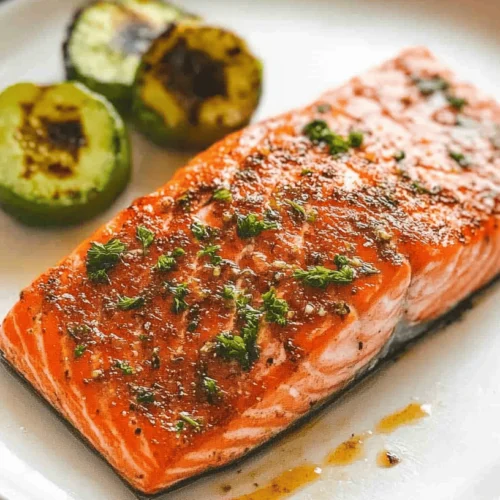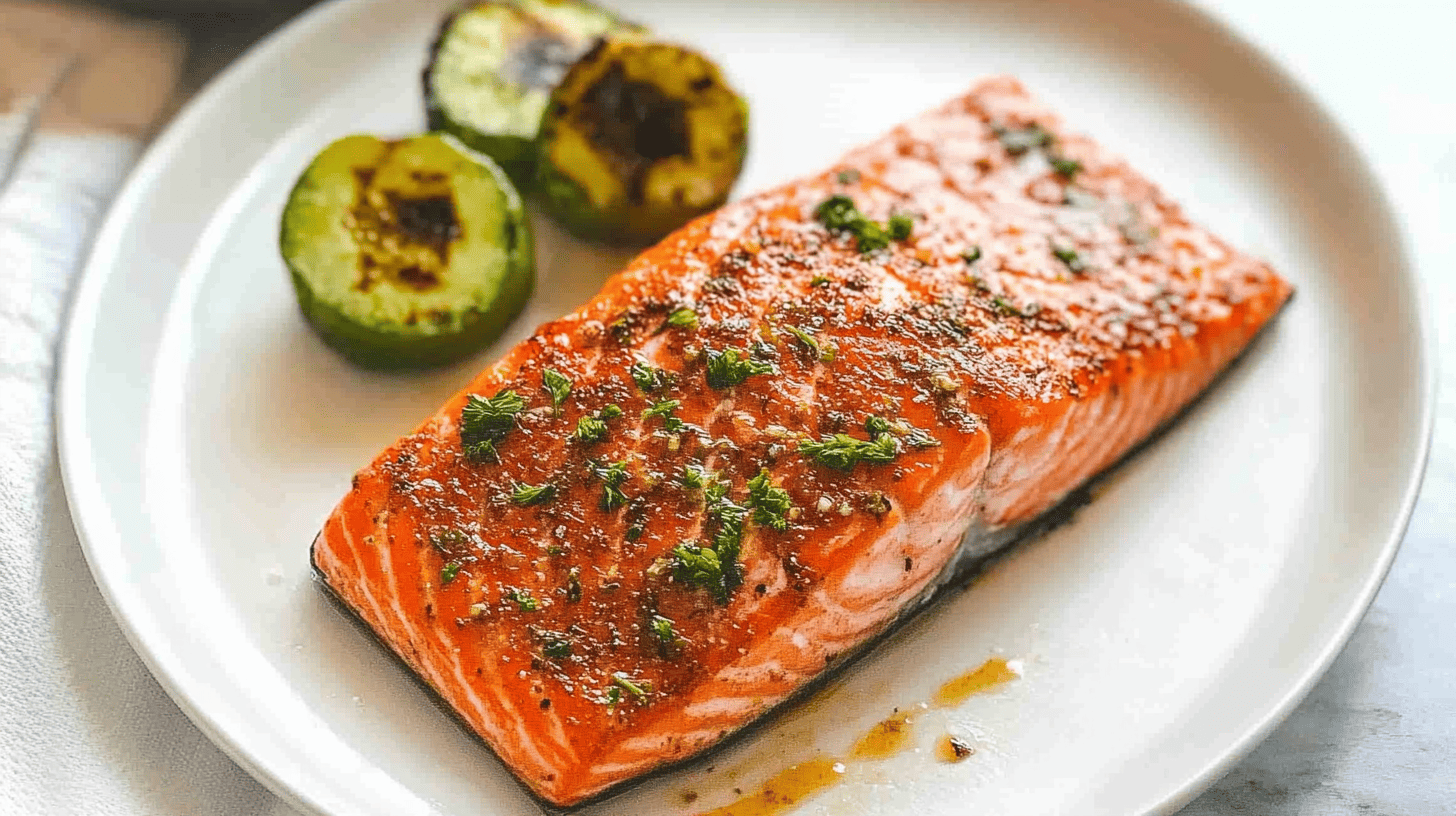Every chef agrees that Norwegian salmon is the top seafood choice. It grows slowly in cold, clean waters. This makes it a special ingredient that turns simple meals into unforgettable dining experiences.
Norwegian salmon is more than just a fish. It’s full of about 22-25 grams of protein per serving. It also has lots of Omega-3 fatty acids, which are good for your heart and brain. Learning how to cook Norwegian salmon can make you a better cook, whether you’re at home or in a professional kitchen.
This guide will teach you how to cook Norwegian salmon like a pro. You’ll learn why it’s loved worldwide, across all ages and diets. We’ll cover everything from picking the right fillet to getting restaurant-quality results.
Imagine cooking a Norwegian salmon that’s tender, tasty, and full of nutrients. With our tips, you’ll improve your cooking and wow your guests. Let’s explore the art of preparing exceptional Norwegian salmon.
Table of Contents
Understanding Norwegian Salmon Quality and Benefits
Norwegian salmon is a top choice for seafood lovers. It comes from Norway’s clean waters. This fish is known for its great taste and health perks.
Norwegian salmon is special in the kitchen. It’s raised in cold, clean waters. This makes it firm and flavorful. Also, 44% of people worldwide choose Norwegian salmon for its quality.
Nutritional Powerhouse
Norwegian salmon is packed with nutrients. It’s full of omega-3 fatty acids. These fats are good for your heart, brain, and more.
- Supports cardiovascular health
- Enhances brain function
- Reduces inflammation
- Contains high-quality protein
Premium Farming Practices
Norwegian salmon farms are known for their green practices. To preserve the environment, they adhere to stringent regulations. They also avoid antibiotics and feed their fish non-GMO food.
- Strict environmental standards
- No antibiotic usage
- Non-GMO diet
- Advanced fish health monitoring
Wild-Caught vs Farm-Raised Insights
The debate between wild-caught and farm-raised salmon is interesting. Wild-caught salmon is natural, but Norwegian farm-raised is consistent. Over 14 million people eat Norwegian salmon every day.
Nutrition experts say Norwegian salmon is great for your heart and overall health.
Essential Kitchen Tools and Equipment for Perfect Salmon
Preparing a delicious Norwegian salmon recipe needs more than just quality ingredients. The right kitchen tools can make your cooking better and help you get professional results.
Must-Have Kitchen Tools for Salmon Preparation
- Sharp Fillet Knife: Precision cutting is crucial for perfect salmon portions
- Fish Turner: Allows gentle flipping without breaking delicate salmon fillets
- Reliable Non-Stick Skillet
- Digital Meat Thermometer
- Citrus Zester
Your Norwegian salmon recipe will stand out with quality equipment. A good non-stick skillet ensures even heating and prevents sticking. A digital meat thermometer helps you get the perfect 145°F internal temperature.
Recommended Kitchen Equipment
| Tool | Purpose | Recommended Type |
|---|---|---|
| Knife | Precise Cutting | 8-inch Fillet Knife |
| Skillet | Cooking Surface | Cast Iron or Non-Stick |
| Thermometer | Temperature Control | Digital Instant-Read |
Professional chefs know that the right tools can make a simple Norwegian salmon recipe amazing. Investing in these essential kitchen tools will help you make restaurant-quality meals at home.
Selecting and Preparing Your Norwegian Salmon
Choosing the right Norwegian salmon is all about knowing what to look for. Norway is a big player in the global salmon market, offering top-notch seafood. Learning how to pick, store, and prepare your salmon will make your meals better.
Choosing Fresh Norwegian Salmon Fillets
When searching for where to buy Norwegian salmon, look for these signs of quality:
- Bright, vibrant color with a consistent sheen
- Firm flesh that springs back when touched
- Clean, ocean-like smell without strong fishy odors
- Minimal liquid in packaging
Storage and Temperature Guidelines
Keeping your salmon fresh is key. Keep it refrigerated at 40°F or lower. Let it sit at room temperature for 10 minutes before cooking. This helps it cook evenly.
| Storage Method | Duration | Recommended Condition |
|---|---|---|
| Refrigerated (Fresh) | 1-2 days | Tightly wrapped, coldest part of refrigerator |
| Frozen | Up to 8 months | Sealed, airtight container |
Basic Preparation Techniques
To get the most out of your salmon, know how to prepare it right. Remove bones with tweezers, pat dry with paper towels, and season lightly. Cook it to 145°F for the best taste and safety.
Experts say grilling, baking, or smoking are the best ways to cook salmon. With the right selection and prep, your salmon will be a hit at any meal.
Gordon Ramsay’s Secret Pan-Searing Technique

Discover the secret to making your Norwegian salmon recipe shine with Gordon Ramsay’s pan-searing technique. This method turns simple salmon into a dish that will wow everyone.
Ramsay’s technique involves several key steps to take your salmon to the next level:
- Score the salmon skin in a precise crosshatch pattern
- Bring salmon to room temperature before cooking
- Use high-quality extra virgin olive oil
- Create a flavorful herb-butter base
Before cooking, make sure your salmon is dry and seasoned well with salt and black pepper. The goal is to get a crispy outside and a juicy inside.
| Technique Element | Ramsay’s Recommendation |
|---|---|
| Pan Temperature | Medium-high heat |
| Cooking Time per Side | 2-3 minutes |
| Fat Used | Olive oil + butter |
| Aromatics | Garlic, thyme |
The last step is to baste the salmon with herbed butter in the last few minutes. This adds amazing flavor and a golden crust, making your dish stand out.
Classic Herb-Crusted Norwegian Salmon Recipe
Making the perfect Norwegian salmon recipe needs care and some secrets. This herb-crusted salmon turns your weeknight dinner into a fancy meal. It’s tasty and full of nutrients.
Start with top-notch ingredients that match the fish’s light taste. The goal is to make a crispy, tasty crust that boosts the salmon’s flavor.
Herb and Panko Mixture Preparation
To make a great herb crust, mix these ingredients for texture and taste:
- 1/4 cup plain breadcrumbs
- 1/4 cup grated parmesan cheese
- 2 cloves minced garlic
- 1 tablespoon finely chopped thyme
- 1 tablespoon finely chopped chives
- 2 tablespoons melted butter
Step-by-Step Coating Process
- Pat salmon fillets dry with paper towels
- Mix breadcrumbs, cheese, and herbs in a shallow dish
- Brush salmon with melted butter
- Coat evenly with herb mixture, pressing gently
Perfect Cooking Temperature and Timing
Get salmon just right with these cooking tips:
| Cooking Parameter | Recommended Setting |
|---|---|
| Oven Temperature | 400°F (204°C) |
| Cooking Time | 10-12 minutes |
| Internal Temperature | 145°F (63°C) |
Pro tip: For a gluten-free version, use crushed rice Chex cereal or gluten-free breadcrumbs instead of regular breadcrumbs.
Your Norwegian salmon recipe is ready to wow! Serve it right away for the best taste.
Mastering the Teriyaki Glazed Salmon

Turn your Norwegian salmon into a dish fit for a restaurant with a tasty teriyaki glaze. This recipe combines the rich taste of wild-caught salmon with Asian-inspired flavors.
To make the perfect teriyaki glaze, pay close attention to the details. Begin by mixing:
- 1/4 cup soy sauce
- 2 tablespoons mirin
- 1 tablespoon honey
- 1 teaspoon fresh ginger
- 2 minced garlic cloves
The secret to a great Norwegian salmon recipe is finding the right mix of sweet and savory. Marinate your salmon for 15-20 minutes to soak up all the flavors.
How you cook your salmon can make a big difference. Here’s how to do it right:
- Preheat your skillet or grill to medium-high heat
- Pat salmon fillets dry with paper towels
- Cook for 6-8 minutes, brushing with teriyaki glaze
- Make sure the internal temperature hits 145°F
Pro tip: Add toasted sesame seeds and chopped green onions on top for a real touch. It makes your Norwegian salmon recipe go from good to amazing.
Your teriyaki glazed salmon will wow everyone. It offers a perfect mix of flavors that highlights the high quality of Norwegian salmon.
Creating Restaurant-Style Salmon Presentation
To make your Norwegian salmon recipe look like it’s from a restaurant, you need to focus on presentation. Your plating skills can make a simple dish look like a work of art. This will impress both your eyes and taste buds.
Professional chefs know that presentation is key. They pay close attention to every detail. This makes each plate a canvas for creativity.
Essential Plating Techniques
- Use the rule of thirds for balance
- Add height and dimension to the plate
- Strategically use negative space
- Choose plate colors that complement the dish
Garnishing for Visual Impact
Garnishes can take your Norwegian salmon recipe from good to great. Choose elements that add color, texture, and flavor.
| Garnish Type | Visual Effect | Flavor Complement |
|---|---|---|
| Fresh Herbs | Vibrant Green Accent | Light, Fresh Notes |
| Microgreens | Delicate Texture | Subtle Earthy Undertones |
| Citrus Zest | Bright Color Pop | Tangy Brightness |
Remember, less is more when it comes to presenting your salmon. Each element should enhance the dish’s look and taste.
Best Side Dishes to Complement Norwegian Salmon
To make your Norwegian salmon recipe even better, pick the right side dishes. These should boost its taste and health benefits. The perfect sides can turn a simple salmon dish into a memorable meal.
Choose sides that match the salmon’s soft texture and high omega-3 content. Fresh veggies and grains are great choices. They’re easy to prepare and don’t take much time.
Quick and Delicious Side Dish Options
- Roasted Fingerling Potatoes: Ready in 30 minutes with crispy edges
- Air-Fryer Sweet Potatoes: Crispy exterior, tender inside
- Cauliflower Rice: Low-carb alternative to traditional grains
- Charred Sugar Snap Peas: Adds vibrant color and crunch
If you want something lighter, try fresh salads. A spinach salad with lemon-dill dressing is perfect. It balances the salmon’s richness nicely.
| Side Dish | Preparation Time | Flavor Profile |
|---|---|---|
| Roasted Brussels Sprouts | 25 minutes | Caramelized, slightly nutty |
| Asparagus with Garlic | 20 minutes | Savory, tender |
| Quinoa Pilaf | 15 minutes | Light, herbal |
Pro tip: Choose seasonal veggies from local markets for the best taste. With just four ingredients, you can make a side dish that makes your meal special.
Wine Pairing and Serving Suggestions
Take your Norwegian salmon recipe to the next level with the right wine. The perfect wine can make your seafood meal even better. It brings out the rich flavors of salmon and makes it feel more delicate.
Finding the best wine for your salmon depends on how it’s cooked and what sauce it has. Different cooking methods and sauces need different wines. This creates a perfect match for your meal.
White Wine Selection Guide
Here are some top picks for wines with salmon:
- Sauvignon Blanc: Its high acidity is great with salmon dishes that have herbs.
- Chardonnay: Its buttery taste goes well with baked or poached salmon and creamy sauces.
- Riesling: Its sweet taste works with many salmon dishes.
Temperature Serving Guidelines
| Wine Type | Serving Temperature | Ideal Salmon Preparation |
|---|---|---|
| Sauvignon Blanc | 45-50°F | Herb-crusted salmon |
| Chardonnay | 50-55°F | Creamy poached salmon |
| Pinot Gris | 45-50°F | Grilled salmon |
Pro tip: Chill your wine a bit before serving. This brings out its crispness and makes it pair better with your salmon.
Common Cooking Mistakes to Avoid
Getting a perfect Norwegian salmon recipe needs skill and precision. Many home cooks make mistakes that ruin a dish. Knowing these common errors can help you cook better salmon.
Top Salmon Cooking Pitfalls
- Overcooking: The most frequent mistake that destroys salmon’s delicate texture
- Incorrect temperature management
- Poor seasoning techniques
- Improper preparation before cooking
Temperature is key when cooking Norwegian salmon. Different cooking guidelines exist for wild-caught and farm-raised salmon:
| Salmon Type | Recommended Temperature | Cooking Considerations |
|---|---|---|
| Wild-Caught Salmon | 120°F | Leaner, quicker to dry out |
| Farm-Raised Salmon | 125°F | More forgiving texture |
Another mistake is marinating too long. Experts say marinate for 20-30 minutes to avoid mushy fish. Always pat the fish dry before cooking to get a good sear and prevent steaming.
Pro Tips for Perfect Salmon
- Use a meat thermometer for precise temperature control
- Allow salmon to reach room temperature before cooking
- Avoid flipping the fish too frequently
- Rest the salmon after cooking to retain moisture
By avoiding these mistakes, you can make your Norwegian salmon recipe amazing. This ensures a delicious dish every time.
Conclusion
Norwegian salmon is more than a meal; it’s a journey of taste and health. This guide has shown you how it combines great flavor, health perks, and eco-friendly farming. It stands out among other seafood choices.
Exploring how to cook it, like pan-searing or teriyaki glazing, shows its versatility. It’s packed with 20g of protein, 1.8g of omega-3s, and key vitamins. Norway’s big salmon production means you can enjoy this global treasure.
Learning about sustainable farming, like closed-pen aquaculture, shows you’re making a responsible choice. This method cuts down on sea lice and environmental harm. The Norwegian salmon industry focuses on quality, with strict water checks and less antibiotic use. This means you get a tasty and eco-friendly meal.
Ready to get better at cooking? With these tips, you can make Norwegian salmon dishes that wow everyone. Dive into the flavors, health, and eco-friendliness of this amazing fish. Your cooking adventure begins today.
FAQ
What makes Norwegian salmon different from other types of salmon?
Norwegian salmon is known for its top-notch quality and taste. It’s farm-raised in marine environments that ensure it’s nutritious and sustainable. This makes it taste richer and butterier than wild-caught salmon.
Is Norwegian salmon healthy?
Yes, it’s very healthy! It’s full of protein, Omega-3s, vitamins D and B12, and minerals. Eating it regularly can help your heart, brain, and reduce inflammation. A serving has about 2-3 grams of Omega-3s, great for a healthy diet.
How much does Norwegian salmon typically cost?
The price of Norwegian salmon varies. It’s usually between and per pound. Fresh, high-quality fillets might cost a bit more. The price depends on quality, cut, and whether it’s organic.
Where can I buy authentic Norwegian salmon?
You can find it at specialty seafood markets, high-end grocery stores like Whole Foods, and online. Major supermarkets also carry it. Make sure the packaging says it’s from Norway for authenticity.
Is Norwegian salmon farm-raised or wild-caught?
It’s mostly farm-raised in Norway’s ocean. These farms follow strict environmental standards. They’re designed to mimic natural conditions, producing high-quality salmon.
Can I use Norwegian salmon for sushi?
Yes, it’s great for sushi! It has a consistent texture and rich flavor. Just make sure it’s sushi-grade to be safe for raw eating.
What are the best cooking methods for Norwegian salmon?
It’s versatile and works well with many cooking methods. Try pan-searing, baking, grilling, broiling, or poaching. Each method brings out its natural flavors and keeps it moist.
How should I store Norwegian salmon?
Keep it in the coldest part of your fridge at 32-38°F. Keep it in its original container or securely wrap it in plastic. Use it within 1-2 days. For longer storage, freeze it at 0°F or below for up to 3 months.
Is Norwegian salmon more sustainable than other salmon?
Yes, it’s very sustainable. Norwegian aquaculture follows strict environmental rules. They focus on minimizing ecological impact and improving technology. Many farms are certified by the Aquaculture Stewardship Council (ASC) for their responsible practices.
What wine pairs best with Norwegian salmon?
Light to medium-bodied white wines pair well. Try Sauvignon Blanc, Chardonnay, Pinot Grigio, or light, unoaked whites. A chilled Pinot Noir can also work with certain salmon dishes.

Norwegian Salmon
Equipment
- Non-Stick Skillet
- Digital Meat Thermometer
- Fish Turner
Ingredients
Salmon Preparation
- 4 fillets Norwegian salmon skin-on, about 6 oz each
- 1 tbsp olive oil
- 1 tsp sea salt
- ½ tsp black pepper
Herb Crust (Optional)
- ¼ cup breadcrumbs
- ¼ cup grated Parmesan cheese
- 2 tbsp fresh parsley chopped
- 1 clove garlic minced
Instructions
- Pat the salmon fillets dry with a paper towel and season with sea salt and black pepper.
- Heat olive oil in a non-stick skillet over medium-high heat.
- Place salmon fillets skin-side down and cook for 4-5 minutes until the skin is crispy.
- Flip the salmon and cook for another 3-4 minutes until the internal temperature reaches 145°F.
- For a herb crust, mix breadcrumbs, Parmesan, parsley, and garlic. Press onto the salmon before flipping and cook until golden.
- Remove from heat and let rest for 2 minutes before serving.

